Schedule
Sorghum Crop Schedule
| Product Name | Fertilizers | |||||||||
|---|---|---|---|---|---|---|---|---|---|---|
| PROM/ Organic Fertilizer |
Poornima Kit | NPK Grow Caps |
Humigrow Neno Powder |
Alp | Sonha-Bihan | IBP-Kit | ||||
| Humic Acid | Chelated Multi-micronutrient |
PGP/PGR | ||||||||
| Land Reparation | week -2 | |||||||||
| Soil Treatment | week -1 | 1 Kit | ||||||||
| Seed Sowing | week 0 | 50 kg | ||||||||
| Germination | week 1 | |||||||||
| Vegetative Growth | week 2 | 1 Kit | ||||||||
| week 3 | ||||||||||
| week 4 | ||||||||||
| week 5 | ||||||||||
| Flowering / Fruiting | week 6 | 2 Caps | 120gm | |||||||
| week 7 | 250gm | 250gm | ||||||||
| week 8 | ||||||||||
| week 9 | ||||||||||
| week 10 | 2 Caps | 120gm | ||||||||
| week 11 | ||||||||||
| week 12 | ||||||||||
| Harvesting | ||||||||||
| Total Quantity | 50 kg | 1 Kit | 4 Caps | 240gm | 250gm | 250gm | 1 Kit | |||
| Broadcast | |
| Top Dressing | |
| Basal Dressing | |
| Soil Application | |
| Spray | |
| * | Optional |
NOTE: For the first year donot immidietaly substitute 100% chemical fertilizer with the SIESTO GREEN products, as the soil is used to chemical fertilizer, it may affect the output. So the best way to substitute is by reducing 50% of chemical input in the first year, 25% the following 2nd year, & then another 10% by the 3rd year. After the 3rd year use synthetic fertilizer / inorganic fertilizer if their is a requirement depending on the soil health.
CROP SCHEDULE FOR WHEAT
| Sr. No. | Treatment / Application | Product | Dose / Acre | Management |
|---|---|---|---|---|
| 1 | Soil Treatment:- Dissolve in 20 to 200 liters of water as per requirement for 1 acre of land and apply through drip irrigation or spraying in the field. | IBP KIT | 1 kit | It is a preventive dosage for any kind of soil-borne disease, nematodes, etc. |
| 2 | Vegetative:- Dissolve in 20 to 200 liters of water as required for 1 acre of land and apply through drip irrigation or mix it with sand, FYM, or soil and broadcast it to the field. | POORNIMA KIT | 1 KIT | It will be applied after the emergence of 2 to 4 leaves. In week 2. |
| 3 | Vegetative:- Dissolve in 20 to 200 liters of water as required for 1 acre of land and apply through drip irrigation or mix it with sand, FYM, or soil and broadcast it to the field. | NPK Grow caps + Humigrow Nanopowder | 2 cap + 120gm | It will be applied in week 6 and 10. |
| 4 | Flowering Stage:- Spray during the flowering period. | ALP + Sonha Bihan | 250gm + 250 gm | Apply after the emergence of flowers. In week 7. |
PEST ATTACKS, BACTERIAL, OR FUNGAL MANAGEMENT
| PEST / BACTERIAL / FUNGAL | IDENTIFICATION IN CROP | SYMPTOMS | SUGGESTED PRODUCT |
|---|---|---|---|
| Stalk Rot | 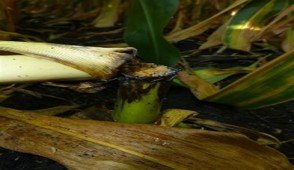 | Premature drying of lower leaves, Soft Internodes & appear tan brown from outside and pink or reddish inside. The pith is completely rotten and the stalk may lodge. | Indofa + Bacillus |
| Downy Mildew | 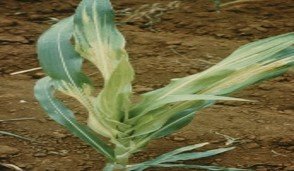 | The symptoms appear on the younger leaves. White or light green stripes appear. A white mat of fungal growth can be seen on the lower or both surfaces of leaves during wet weather. | Indofa + Bacillus |
| Leaf Blight | 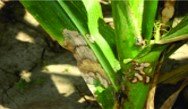 | The disease symptoms appear as boat-shaped, light grey or brown lesions on lower leaves and also on upper leaves. The cobs are small & poorly filled. | Indofa + Bacillus |
| Maydis Leaf spot |  | It appears in a large number of minute to large spots of 3.75 cm long and 1.75 cm in width on leaves. The lesions are oval. These lesions coalesce and leaves may show brown-colored stripes. | Indofa + Bacillus |
| Grey Leaf Spot | 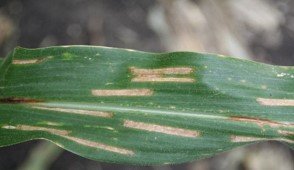 | The disease is caused by Cercospora zeae-maydis. The leaf spots are brown, narrow & long which become ash grey in humid weather. | Indofa + Bacillus |
| Nematodes | 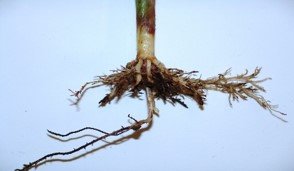 | Stunting and/or yellowing of foliage and stunting, swelling, and/or browning of roots. | Pacliq |
| Spotted Stem Borer | 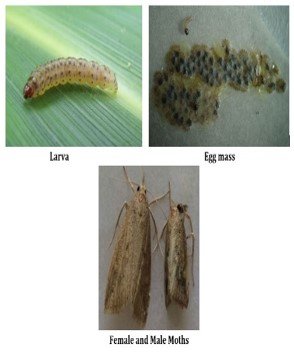 | Larvae feed in whorls, causing small windows after the leaf grows out, and some leaves are even rolled up. The larvae tunnel into the stem and inside the stem. Larvae can also tunnel into the ears, leading to direct yield losses. | Meta + Traps + BT |
| Aphids | 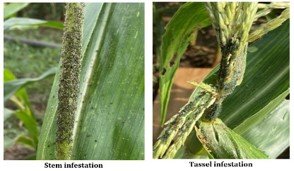 | Both nymphs and adults suck the sap from the plant, especially the leaves. This turns the leaves yellow and in the case of heavy infestation, the plants remain stunted. | Lifeline + Traps + BT |
| Pink Stem Borer | 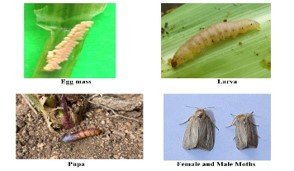 | On hatching, pink borer larvae feed in concealment inside the leaf sheath in groups and feed on the epidermal layer of the leaf sheath preferably on the first three leaf sheaths. | Meta + Traps + BT |
| Fall Armyworm | 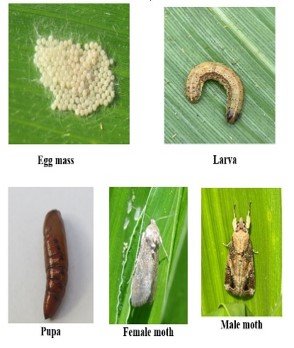 | FAW attacks all stages of maize crop from seedling emergence to ear development. The young larvae of FAW feed in and around the whorl leaves by scraping and skeletonizing the upper epidermis leaving a silvery transparent membrane resulting in papery spots. | Meta + Traps + BT |
| Termites | 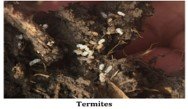 | Termite invasion initiates from dry leaves. Later roots as well as the lower part of the stem are destroyed resulting in lodging. | Meta + Traps + BT |
| Cut Worm | 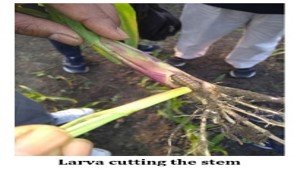 | Females lay about 300 creamy white dome-shaped eggs. The freshly hatched larva is slightly yellowish in color with a black head. The full-grown larva is greasy in appearance, plump, and dark brown in color with a red head. | Meta + Traps + BT |
| Army Worm | 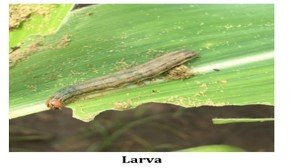 | Plants are damaged by caterpillars. Larvae feed on tender leaves and skeletonize them. In the case of a severe attack, leaves including midribs are eaten away and the fields look as if grazed by cattle. | Meta + Traps + BT |
| Tobacco Caterpillar | 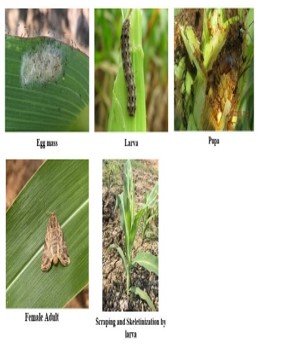 | On hatching, the larvae feed on tender leaves in groups. They scrape the surface but do not actually perforate it, creating a window pane effect. | Meta + Traps + BT |
NUTRITION DEFICIENCY IN PADDY CROP
| NUTRIENT DEFICIENCY | IDENTIFICATION | SYMPTOMS | SUGGESTED PRODUCT |
|---|---|---|---|
| Nitrogen Deficiency | 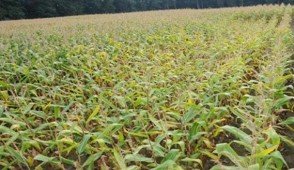 | Affected plants show spindly, sparse growth. On the older leaves, V-shaped yellowing on the leaf tips progresses towards the base, so that leaves finally turn uniformly pale green/yellow. | Azoss Caps |
| Phosphorus Deficiency | 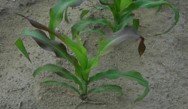 | Young plants are dwarfed and thin with dark green leaves. Leaf margins, veins, and stems show purple tints which may spread over the whole leaf blade. | PSB Plus Caps |
| Potassium Deficiency | 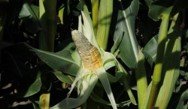 | The cobs of K-deficiency plants are small and peaked. Grains in the cob tips are only poorly filled. | Potash Grow Caps |
| Sulfur Deficiency |  | The plant shows stunted, erect growth. Seen from a distance, younger leaves are colored uniformly pale, but when you look at them closely, it’s rather an interveinal chlorosis. | Sulphur Caps |
| Manganese Deficiency | 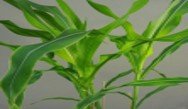 | Slight manganese undersupply produces hardly any visible symptoms. Severely affected plants show pale foliage with flaccid growth forms. The leaves become chlorotic with white interveinal streak lesions. | Alp |
| Zinc Deficiency | 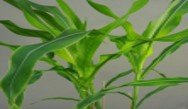 | Pale yellow chlorotic zones run parallel to the midrib starting at the base of leaves. The leaf margin, tip, and midrib remain green. | Zinc Grow Caps |
| Boron Deficiency | 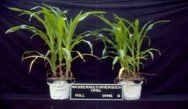 | Yellow or white spots may develop on leaves with brown waxy raised streaks as deficiency develops. Growth is stunted with shortened internodes. | Alp |
| Copper Deficiency | 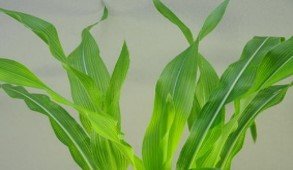 | The youngest leaves show yellow interveinal discoloration as they come out of the whorl. Mainly the basal part of the leaf is uniformly yellow-green. | Alp |
| Iron Deficiency | 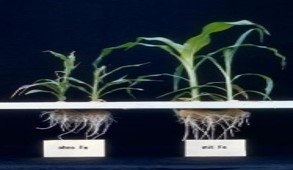 | The plant shows stunted growth. At severe deficiency, necrotic zones develop at leaf margins and tips. | Alp |
KEY FARMING POINTS
KEY FARMING POINTS
- SOIL TYPE = Sorghum is a relatively adaptable crop that can be grown in a variety of soil types. However, it prefers well-drained, fertile soils. Sorghum can tolerate poor soils, but it will produce higher yields in fertile soils.
- SOIL PH = 5 to 8.5
- CLIMATE / TEMPERATURE = Sorghum is a warm-season crop that requires high temperatures for good germination and growth. The ideal temperature for sorghum development is between 27 and 30 degrees Celsius. Sorghum can tolerate temperatures as low as 18 degrees Celsius, but growth will be slowed. Sorghum is also sensitive to frost, so it is important to wait until the last frost date before planting.
- SPACING = The recommended spacing for sorghum plantation varies depending on the variety of sorghum, the climate, and the desired yield. However, a general rule of thumb is to plant sorghum seeds 12 to 18 inches apart in rows that are 3 to 4 feet apart. This spacing will give the plants enough room to grow and produce a good yield.
- MANURING & FERTILIZATION = Fertilizer requirements depend on the fertility or quality of the soil.
- WATER MANAGEMENT = Sorghum is a relatively drought-tolerant crop, but it does require regular watering to produce a good yield. The ideal soil moisture level for sorghum is between 60 and 70% of field capacity. Field capacity is the amount of water that a soil can hold after it has been drained.
- HARVESTING DURATION = The harvesting duration of sorghum depends on the variety, local weather conditions, and intended use of the crop. Sorghum is typically harvested 100 to 140 days after sowing, generally in September to mid-October, when the grains have become hard. The crop can be harvested by hand by either cutting the heads or pulling the whole plant and cutting the heads later.
- YIELD = The yield of sorghum depends on various factors such as the variety, soil type, climate, and farming practices. The average yield of sorghum is around 5 tons per hectare.However, the yield can vary widely depending on the growing conditions and the variety of sorghum used.


